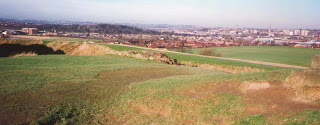The 15th century is not short of villains, but the
interpretation of the word depends on whose side you were on. The Lancastrians looked on Richard, duke of York and his sons as villains; the Yorkists considered the weak king Henry VI, and especially his wife Margaret of Anjou as villains. Richard Neville, earl of Warwick, changed sides. So did Lord Hastings and the Duke of Buckingham. Then there was Margaret Beaufort and her son, Henry Tudor.
My top vote,
however, goes to the Stanleys.
Thomas Stanley, 1st Earl of Derby, (1435-1504) was a landed
nobleman in the 15th century who somehow managed to stay on the winning side
throughout the Wars of the Roses. Because of his immense power, both sides
needed (and sometimes demanded, threatened or begged for) his support.
His father held important roles at the court of Henry VI and
Stanley’s early loyalty was to the Lancastrian king. However, his marriage to
Eleanor Neville, sister of Richard Neville, Earl ofWarwick, brought him into
alliance with the Yorkists. In 1459,when his father-in-law, the Earl of
Salisbury, was mobilising his forces against the royal forces, Stanley was
ordered by the Queen to intercept him, but when the two forces met at Blore
Heath in Staffordshire, Stanley kept his 2,000 forces out of the battle.
The following year, Stanley openly cooperated with the Yorkists,
and joined with his brother-in-law, the Earl of Warwick in his campaigns with
the Lancastrians. When Warwick rebelled against Edward IV, Stanley lent him
armed support. However, on Edward IV’s defeat of Warwick in 1471, Stanley
became a member of the royal council.
The death of his wife around this time ended his connection
with the Nevilles. His second marriage was to have far greater consequences, as
his new wife was Lady Margaret Beaufort, who had previously been married to
Edmund Tudor. Her child by this marriage was, of course, Henry Tudor.
When Edward IV died unexpectedly in 1483, Stanley was one of
the members of the royal council who tried to maintain a balance of power
between Richard, Duke of Gloucester and the Woodville family. When Richard
denounced the council, Stanley escaped the fate of Lord Hastings who was
executed, but he was imprisoned for a time. However, when Richard became king,
he found it more advisable to appease rather than alienate the Stanley family.
Thus Stanley continued to act as steward of the royal household and bore the
mace at Richard’s coronation.
He supported Richard in suppressing Buckingham’s revolt in
the autumn of 1483, even though it is
highly likely he was actually involved in the conspiracy. Certainly his wife
was one of the co-conspirators in the plot to dethrone Richard and put Henry
Tudor on the throne. Stanley only escaped attainder by promising Richard that
he would keep his wife in custody and end her intrigues.
In early 1485, Stanley asked permission to leave the court
to attend to his northern estates. Richard was clearly aware of the threat from
the Stanley family, and insisted that his son, Lord Strange, remained at court
as a token for his father’s loyalty.
When Henry Tudor’s forces advanced through Wales in the
summer of 1495, Richard ordered Stanley to join him, but Stanley made an excuse,
saying he had the sweating sickness. By this time Richard had evidence of
Stanley’s treachery since Lord Strange had confessed that his father and uncle
William Stanley had conspired with Henry Tudor. Richard sent a message to
Stanley saying that Lord Strange’s life depended on Stanley’s loyalty in the
coming conflict. Apparently, Stanley’s reply was, “Sire, I have other sons.”
Nice father, huh?
Stanley and his brother William led their forces south to
the Midlands, but they took up a position separate from both Richard’s and
Henry Tudor’s forces at Bosworth Field. The general consensus of historians is
that he was waiting to see who was the likely winner before showing his hand.
Only when Richard led his magnificent charge towards Tudor did the Stanleys
act. William led his forces to Henry’s aid, and Richard was surrounded and
killed.

Legend has it that, when the battle was over, Thomas Stanley
discovered the coronet that had fallen from Richard’s head, and placed it on
his stepson’s head, no doubt to show that Henry Tudor owed his victory to the
Stanleys. Thomas was rewarded with the office of High Constable of
England, together with other estates and offices, and was godfather to Henry’s
oldest son Arthur in 1486.
In the Derby chapel at Ormskirk Church in Lancashire there
are effigies thought to be those of Thomas Stanley and his first wife, Eleanor
Neville. He was actually buried in the family chapel at nearby Burscough Priory
and it is thought the effigies were
brought to Ormskirk Church when the priory was demolished when the
monasteries were dissolved in 1536.
It’s worth considering for a moment that the treachery of
the Stanleys at Bosworth changed the course of English history. Without their
intervention, Richard would probably have killed Henry Tudor, thereby securing
his throne. There would have been no Tudor dynasty, no Henry VIII, no break
with Rome, no Elizabeth I – and maybe Shakespeare would have written a play
about the despised Tudor would-be usurper and his traitorous Stanley acolytes!























































